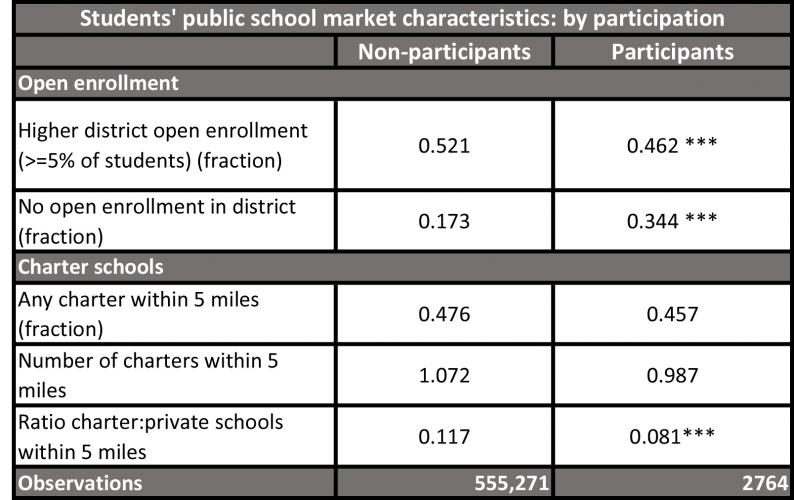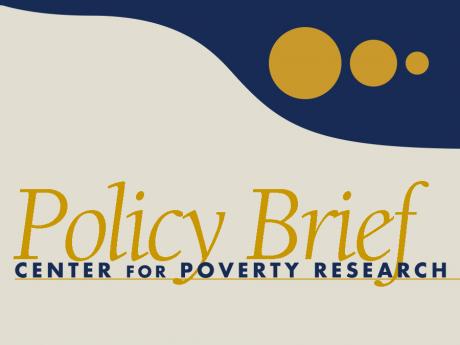Private Schools & Public Options Help Predict Which Families Use Vouchers
By Cassandra M.D. Hart, UC Davis
Research suggests that violence and low academic performance in public schools play a big role in a family’s decision to use state-funded vouchers to send their children to a private school. However, little research has considered the impact of nearby private and public school markets.
In the most detailed observational research to date, Center for Poverty Research Faculty Affiliate Cassandra Hart examines the largest voucher program in the country: Florida’s Tax Credit Scholarship Program.
Key Findings:
• Participants in Florida’s tuition voucher program disproportionately come from low-performing public schools with more disruptive environments.
• Participants disproportionately come from areas with more convenient and diverse private school options.
• Families are less likely to use vouchers for private schools when they have nearby public options, like open enrollment and charter schools.
School voucher programs have become increasingly widespread in recent years. Classic voucher programs exist in cities such as in Milwaukee and Cleveland, while “neovoucher” programs—which provide students with scholarships funded by tax creditable contributions—serve students in states such as Florida and Pennsylvania.
A healthy body of research has already examined the individual characteristics of families who use vouchers to send their children to safer, higher-performing private schools. This study expands the scope of research by examining the characteristics of students’ original public schools, as well as characteristics of both public and private school markets, to find out how they predict participation in the means-tested Florida Tax Credit Scholarship Program.
The study finds that participants are more likely than eligible non-participants to come from public schools with worse overall academic performance, higher rates of violent and non-violent disciplinary incidents, and out-of-school suspensions, as well as more negative school climates according to both teacher and principal ratings.
However, private school and public school markets matter too. Participants tend to have more convenient and varied private school options than eligible students who do not participate. Students are also less likely to participate when they have access to more public school options.
Florida’s Voucher Program and School
Markets
Starting with microdata from the Florida Department of Education
on the nearly 35,000 students who applied to Florida’s tuition
voucher program for the 2008-09 school year, this study focuses
on eligible elementary school-aged students who attended public
schools immediately before applying. Hart compares this subset of
2,764 new “participants” against 555,271 eligible elementary
school-aged “non-participants.”
Hart uses a number of different sources to examine the public
school climate, including administrative data, Florida School
Indicator Reports data on disciplinary incidents and suspension
rates, and 2004 and 2005 surveys of principals and teachers
collected by researchers at the University of Florida, the Urban
Institute and Princeton University.
To gauge market competition between private and public school
options, Hart compares the density of private and public
alternatives faced by participants’ and non-participants’ home
schools.
Participants’ Original Public
Schools
Participants in Florida’s tuition voucher program tend to come
from schools with higher proportions of African American students
and lower proportions of White or Hispanic students. Participants
are more likely to be African American and less likely to be
white or Hispanic. Participants are also more likely to use free
rather than reduced-price lunch, and are lower-achieving compared
to their non-participant peers. Participants disproportionately
come from low-performing public schools with significantly higher
rates of violent and non-violent incidents and out-of-school
suspensions.
While participants were significantly less likely to come from public schools where principals rated new teachers in their school as “excellent,” in other ways public school teacher qualities are only loosely related to whether parents will use vouchers to enroll their children in private schools. The share of teachers with advanced degrees is slightly smaller in participant schools. Between participant and non-participant public schools, teachers differ only slightly on what most would consider important factors like time spent with low-performing students.
Private and Public Options
The private school markets near participants are significantly
more competitive than the markets near non-participants.
Participants’ public schools are nearly a mile closer to the
nearest private school, with many more private schools of
different types within a five-mile radius. The nearby private
school market, however, does not entirely explain why some
parents choose private options for their children.
This study links fewer public options, such as open enrollment or charter schools, to the likelihood families will seek out private schools for their children. Open enrollment provides an opportunity for families to enroll their children in public schools outside of their assigned district school.
The Florida Department of Education’s 2008-09 report on open enrollment showed that for the previous year, over 12 percent of students statewide used open enrollment options, with significant variation from district to district. Seventeen of Florida’s 67 districts had fewer than five students in the entire district using open enrollment options, and that about a third of all participants in the vouchers program came from those 17 districts. That was about twice the share of non-participants attending school in those districts.
Comparing the proportion of charter schools to private schools in a five-mile radius of participant and non-participant public schools, this study finds significantly fewer charter schools per private school near participants suggesting that having fewer public options relative to private ones may be a factor in families’ decisions to participate in Florida’s tuition vouchers program.
However, access to charters within five miles is not significantly related to voucher participation. Taken together, the results suggest that both private school and public school markets, as well as characteristics of students’ own public schools, are associated with participation in voucher programs.
Meet the Researcher
Cassandra M.D. Hart is Assistant Professor of Education
Policy at the University of California, Davis. Her recent
research focuses on the effects of school choice, including
studies on the Florida Tax Credit Scholarship and the effects of
means-tested school vouchers scholarships.












